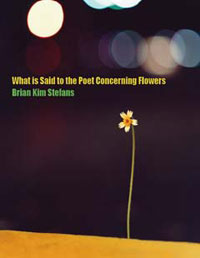Factory School, 2006 Reviewed by C St Perez
|
In What is Said to the Poet Concerning Flowers, Brian Kim Stefans quotes musician Brian Eno: “With punk, a brand-new axis opened up: professionally cut [/] hacked about by a brainless cretin. As often happens, this appeared (and was intended) to be an anti-style style […] The effect was not to overthrow and eliminate the idea of style but to give it new places in which to extend itself” (89). Stefans’s poetry, extended through the axis of punk, offers new possibilities for a “punk-avant” rebellion. Throughout What is Said, Stefans incorporates themes that we wouldn’t normally associate with “flowers” or other romanticized poetic themes. At different moments, we read: “Calibanic fortune-cookies at Studio 54” (61); “Visitors: a talcum blind, Jihad vs. / McWorld” (53); “a dark humor obtained, a cyber-sexual, / middle-aged vaudeville of what was relentless” (65); and (my personal favorite) “Philip K. Dick channeling Spicerian Lenny Bruce through old coffee radio / of insomniac Chomskyite nites” (84). Stefans describes his praxis in the poem “This Method is Poetry”:
His “anti-style style” places us on the stage of poetic rebellion, where the poet’s desire “to create a situation becomes [his] only cause” (31). Stefans mentions International Situationist member Guy Debord in this collection, perhaps to point us to the situationist idea of “derive,” a spontaneous drifting through varied ambiances. The poem “Midas Ears” is exemplary of Stefans’s ability to create a situation:
His poetic inclinations fluidly shift tones and textures, reveling in his instincts to let anything enter. Formally, What is Said presents so many different techniques that the book reads like a volume of “selected poems.” Perhaps this is not so far from the truth: on the acknowledgements page, we learn that What is Saidcomprises 6 previously published chapbooks, along with other poems, a play, and a short comic (a collaboration with poet and artist Gary Sullivan). This impressive range promises aesthetic revolution:
|
Friday, June 17, 2022
Brian Kim Stefans
Subscribe to:
Post Comments (Atom)
Robert Hass
The Failure of Buffalo to Levitate Millard Fillmore died here. His round body is weighted by marble angels. He lies among the great orator...
 WHAT IS SAID TO THE POET CONCERNING FLOWERS
WHAT IS SAID TO THE POET CONCERNING FLOWERS
No comments:
Post a Comment